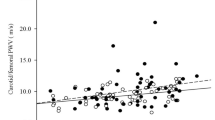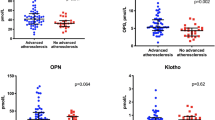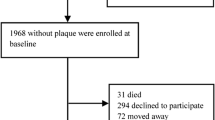Abstract
Osteoporosis and vascular disease are commonly found together in elderly people. Several common mechanisms and risk factors have been suggested to contribute to the development of osteoporosis and atherosclerosis. The present cross-sectional study was performed to determine whether the degree of bone turnover is correlated to carotid intima-media thickness (CCA-IMT), as a marker of subclinical atherosclerosis. We selected 50 outpatients (mean age 71.7 ± 12.3), underwent to eco-Doppler evaluation of extracranial carotid tract, without history of calcium and/or vitamin D supplementation, or antireabsorptive therapy. CCA-IMT was measured by high-resolution B-mode ultrasonography. Bone turnover was evaluated by analysing serum levels of C-terminal telopeptide of type I collagen (sCTX), and bone-specific alkaline phosphatase. We also evaluated the vitamin D status by determination of the serum concentration of 25-hydroxyvitamin D [25(OH)D]. We found a prevalence of hypovitaminosis D [serum 25(OH)D levels <30 ng/mL, mean value 10.7 ± 5.8] of 91.8%, and an increased bone resorption, with mean sCTX levels higher than reference values (mean 1.18 ± 0.57 ng/mL). A significant positive correlation was found between CCA-IMT and age (r = 0.480, P = 0.001), erythrocyte sedimentation rate (ESR: r = 0.438, P = 0.001), high-sensitivity C-Reactive Protein (HsCRP: r = 0.482, P = 0.011), serum creatinine (r = 0.305, P = 0.031), and sCTX (r = 0.389, P = 0.006). In a multivariate linear regression, CCA-IMT was independently predicted by age (β = 0.34, P = 0.001), ESR (β = 0.37, P = 0.005), and sCTX (β = 0.32, P = 0.006). The preliminary results of our study seem to indicate that after adjustment for established cardiovascular risk factors, sCTX independently predict an increased CCA-IMT in the elderly population.



Similar content being viewed by others
References
Naves M, Rodríguez-García M, Díaz-López JB et al (2008) Progression of vascular calcifications associated with greater bone loss and increased bone fractures. Osteoporos Int 19:1161–1166
Szulc P, Kiel DP, Delmas PD (2008) Calcifications in the abdominal aorta predict fractures in men: MINOS study. J Bone Miner Res 23:95–102
de Groot E, van Leuven SI, Duivenvoorden R et al (2008) Measurement of carotid intima-media thickness to assess progression and regression of atherosclerosis. Nat Clin Pract Cardiovasc Med 5:280–288
Sumino H, Ichikawa S, Kasama S et al (2008) Relationship between carotid atherosclerosis and lumbar spine bone mineral density in postmenopausal women. Hypertens Res 31:1191–1197
Tekin GO, Kekilli E, Yagmur J et al (2008) Evaluation of cardiovascular risk factors and bone mineral density in post menopausal women undergoing coronary angiography. Int J Cardiol 131:66–69
Shanahan CM (2005) Mechanisms of vascular calcification in renal disease. Clin Nephrol 63:146–157
Demer LL (2002) Vascular calcification and osteoporosis: inflammatory responses to oxidized lipids. Int J Epidemiol 31:737–741
Michos ED, Melamed ML (2008) Vitamin D and cardiovascular disease risk. Curr Opin Clin Nutr Metab Care 11:7–12
Hofbauer LC, Brueck CC, Shanahan CM et al (2007) Vascular calcification and osteoporosis-from clinical observation towards molecular understanding. Osteoporos Int 18:251–259
Garnero P (2008) Biomarkers for osteoporosis management: utility in diagnosis, fracture risk prediction and therapy monitoring. Mol Diagn Ther 12:157–170
Okabe R, Inaba M, Nakatsuka K et al (2004) Significance of serum CrossLaps as a predictor of changes in bone mineral density during estrogen replacement therapy; comparison with serum carboxyterminal telopeptide of type I collagen and urinary deoxypyridinoline. J Bone Miner Metab 22:127–131
Garnero P, Hausherr E, Chapuy MC et al (1996) Markers of bone resorption predict hip fracture in elderly women: the EPIDOS prospective study. J Bone Miner Res 11:1531–1538
Brown JP, Josse RG (2002) Scientific Advisory Council of the Osteoporosis Society of Canada. 2002 clinical practice guidelines for the diagnosis and management of osteoporosis in Canada. CMAJ 12:S1–S34
Cifkova R, Erdine S, Fagard R et al (2003) ESH/ESC Hypertension Guidelines Committee. Practice guidelines for primary care physicians: 2003 ESH/ESC hypertension guidelines. J Hypertens 21:1779–1786
American Diabetes Association (2008) Diagnosis and classification of diabetes mellitus. Diabetes Care 31:S55–S60
Adult Treatment Panel III (2002) Final report. Circulation 106:3143–3421
Hollis BW (2008) Assessment of vitamin D status and definition of a normal circulating range of 25-hydroxyvitamin D. Curr Opin Endocrinol Diabetes Obes 15:489–494
Lorenz MW, Markus HS, Bots ML et al (2007) Prediction of clinical cardiovascular events with carotid intima-media thickness: a systematic review and meta-analysis. Circulation 115:459–467
Tamaki J, Iki M, Hirano Y et al (2009) Low bone mass is associated with carotid atherosclerosis in postmenopausal women: the Japanese population-based osteoporosis (JPOS) cohort study. Osteoporos Int 20:53–60
Trento LK, Pietropolli A, Ticconi C et al (2009) Role of type I collagen C telopeptide, bone-specific alkaline phosphatase and osteocalcin in the assessment of bone status in postmenopausal women. J Obstet Gynaecol Res 35:152–159
Choi HJ, Im JA, Kim SH (2008) Changes in bone markers after once-weekly low-dose alendronate in postmenopausal women with moderate bone loss. Maturitas 60:170–176
Binkley N, Silverman SL, Simonelli C et al (2009) Monthly ibandronate suppresses serum CTX-I within 3 days and maintains a monthly fluctuating pattern of suppression. Osteoporos Int (Jan 15)
Siepi D, Marchesi S, Vaudo G et al (2008) Preclinical vascular damage in white postmenopausal women: the relevance of osteoprotegerin. Metabolism 57:321–325
Erdogan B, Aslan E, Bagis T et al (2004) Intima-media thickness of the carotid arteries is related to serum osteoprotegerin levels in healthy postmenopausal women. Neurol Res 26:658–661
Nagata-Sakurai M, Inaba M, Goto H et al (2003) Inflammation and bone resorption as independent factors of accelerated arterial wall thickening in patients with rheumatoid arthritis. Arthritis Rheum 48:3061–3067
Shioi A, Katagi M, Okuno Y et al (2002) Induction of bone-type alkaline phosphatase in human vascular smooth muscle cells: roles of tumor necrosis factor-alpha and oncostatin M derived from macrophages. Circ Res 91:9–16
Dhore CR, Cleutjens JP, Lutgens E et al (2001) Differential expression of bone matrix regulatory proteins in human atherosclerotic plaques. Arterioscler Thromb Vasc Biol 21:1998–2003
Boström K, Watson KE, Horn S et al (1993) Bone morphogenetic protein expression in human atherosclerotic lesions. J Clin Invest 91:1800–1809
Shanahan CM, Cary NR, Metcalfe JC et al (1994) High expression of genes for calcification-regulating proteins in human atherosclerotic plaques. J Clin Invest 93:2393–2402
Massey HM, Flanagan AM (1999) Human osteoclasts derive from CD14- positive monocytes. Br J Haematol 106:167–170
Udagawa N, Takahashi N, Akatsu T et al (1990) Origin of osteoclasts: mature monocytes and macrophages are capable of differentiating into osteoclasts under a suitable microenvironment prepared by bone marrow-derived stromal cells. Proc Natl Acad Sci USA 87:7260–7264
Busti C, Falcinelli E, Momi S et al (2009) Matrix metalloproteinases and peripheral arterial disease. Intern Emerg Med (Sep 24)
Luo XH, Guo LJ, Shan PF et al (2006) Relationship of circulating MMP-2, MMP-1, and TIMP-1 levels with bone biochemical markers and bone mineral density in postmenopausal Chinese women. Osteoporos Int 17:521–526
Pennisi P, Signorelli SS, Riccobene S et al (2004) Low bone density and abnormal bone turnover in patients with atherosclerosis of peripheral vessels. Osteoporos Int 15:389–395
Herrmann M, Seibel MJ (2008) The amino- and carboxyterminal cross-linked telopeptides of collagen type I, NTX-I and CTX-I: a comparative review. Clin Chim Acta 393:57–75
Linnebur SA, Vondracek SF, van de Griend JP et al (2007) Prevalence of vitamin D insufficiency in elderly ambulatory outpatients in Denver, Colorado. Am J Geriatr Pharmacother 5:1–8
Watson KE, Abrolat ML, Malone LL et al (1997) Active serum vitamin D levels are inversely correlated with coronary calcification. Circulation 96:1755–1760
Scragg R, Jackson R, Holdaway IM et al (1990) Myocardial infarction is inversely associated with plasma 25-hydroxyvitamin D3 levels: a community-based study. Int J Epidemiol 19:559–563
Poole KE, Loveridge N, Barker PJ et al (2006) Reduced vitamin D in acute stroke. Stroke 37:243–245
Delmas PD, Eastell R, Garnero P et al (2000) The use of biochemical markers of bone turnover in osteoporosis. Osteoporos Int 6:S2–S17
Budek AZ, Hoppe C, Michaelsen KF et al (2007) Associations of total, dairy, and meat protein with markers for bone turnover in healthy, prepubertal boys. J Nutr 137:930–934
Conflict of interest
None.
Author information
Authors and Affiliations
Corresponding author
Rights and permissions
About this article
Cite this article
Leli, C., Pasqualini, L., Vaudo, G. et al. Carotid intima-media thickness and bone turnover: the role of C-terminal telopeptide of type I collagen. Intern Emerg Med 5, 127–134 (2010). https://doi.org/10.1007/s11739-010-0356-y
Received:
Accepted:
Published:
Issue Date:
DOI: https://doi.org/10.1007/s11739-010-0356-y




